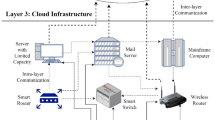Abstract
In conventional cloud computing technology, cloud resources are provided centrally by large data centers. For the exponential growth of cloud users, some applications, such as health monitoring and emergency response with the requirements of real-time and low-latency, cannot achieve efficient resource support. Therefore, fog computing technology has been proposed, where cloud services can be extended to the edge of the network to decrease the network congestion. In fog computing, the idle resources within many distributed devices can be used for providing services. An effective resource scheduling scheme is important to realize a reasonable management for these heterogeneous resources. Therefore, in this paper, a two-level resource scheduling model is proposed. In addition, we design a resource scheduling scheme among fog nodes in the same fog cluster based on the theory of the improved non-dominated sorting genetic algorithm II (NSGA-II), which considers the diversity of different devices. MATLAB simulation results show that our scheme can reduce the service latency and improve the stability of the task execution effectively.







Similar content being viewed by others
References
Evans, D. (2011). The internet of things: How the next evolution of the internet is changing everything[J]. CISCO White Paper, 2011(1), 1–11.
Bonomi, F. (2011). Connected vehicles, the internet of things, and fog computing[C]. In The eighth ACM international workshop on vehicular inter-networking (VANET), Las Vegas, USA (pp. 13–15).
Vaquero, L. M., & Rodero-Merino, L. (2014). Finding your way in the fog: Towards a comprehensive definition of fog computing[J]. ACM SIGCOMM Computer Communication Review, 44(5), 27–32.
Gupta, H., Dastjerdi, A. V., Ghosh, S. K., et al. (2016). iFogSim: a toolkit for modeling and simulation of resource management techniques in internet of things, edge and fog computing environments[J]. arXiv preprint arXiv:1606.02007.
Aazam, M., & Huh, E. N. (2015). Dynamic resource provisioning through fog micro datacenter[C]. In 2015 IEEE international conference on pervasive computing and communication workshops (PerCom workshops) (pp. 105–110). IEEE.
Stojmenovic, I., & Wen, S. (2014). The fog computing paradigm: Scenarios and security issues[C]. In 2014 federated conference on computer science and information systems (FedCSIS) (pp. 1–8). IEEE.
Hu, P., Ning, H., Qiu, T., et al. (2017). Fog computing-based face identification and resolution scheme in internet of things[J]. IEEE Transactions on Industrial Informatics, 13(4), 1910–1920.
Pham, X. Q., & Huh, E. N. (2016). Towards task scheduling in a cloud-fog computing system[C]. In 2016 18th Asia-Pacific Network Operations and Management Symposium (APNOMS) (pp. 1–4). IEEE.
Sarkar, S., & Misra, S. (2016). Theoretical modelling of fog computing: A green computing paradigm to support IoT applications[J]. IET Networks, 5(2), 23–29.
Nishio, T., Shinkuma, R., Takahashi, T., et al. (2013). Service-oriented heterogeneous resource sharing for optimizing service latency in mobile cloud[C]. In Proceedings of the first international workshop on Mobile cloud computing & networking (pp. 19–26). ACM.
Al Faruque, M. A., & Vatanparvar, K. (2016). Energy management-as-a-service over fog computing platform[J]. IEEE Internet of Things Journal, 3(2), 161–169.
Deng, R., Lu, R., Lai, C., et al. (2015). Towards power consumption-delay tradeoff by workload allocation in cloud-fog computing[C]. In 2015 IEEE International Conference on Communications (ICC) (pp. 3909-3914). IEEE.
Xu, Y., Li, K., He, L., et al. (2013). A DAG scheduling scheme on heterogeneous computing systems using double molecular structure-based chemical reaction optimization[J]. Journal of Parallel and Distributed Computing, 73(9), 1306–1322.
Xu, Y., Li, K., Khac, T. T., et al. (2012). A multiple priority queueing genetic algorithm for task scheduling on heterogeneous computing systems[C]. In 2012 IEEE 14th International Conference on High Performance Computing and Communication & 2012 IEEE 9th International Conference on Embedded Software and Systems (HPCC-ICESS) (pp. 639–646). IEEE.
Deb, K., Pratap, A., Agarwal, S., et al. (2002). A fast and elitist multiobjective genetic algorithm: NSGA-II[J]. IEEE Transactions on Evolutionary Computation, 6(2), 182–197.
Aazam, M., & Huh, E. N. (2015). Fog computing micro datacenter based dynamic resource estimation and pricing model for IoT[C]. In 2015 IEEE 29th international conference on advanced information networking and applications (AINA) (pp. 687–694). IEEE.
Wang, D., Yang, Y., & Mi, Z. (2015). A genetic-based approach to web service composition in geo-distributed cloud environment[J]. Computers & Electrical Engineering, 43, 129–141.
Friedman, M. (1937). The use of ranks to avoid the assumption of normality implicit in the analysis of variance[J]. Journal of the American Statistical Association, 32(200), 675–701.
Acknowledgements
We thank American Journal Experts (AJE) for its linguistic assistance during the preparation of this manuscript.
Author information
Authors and Affiliations
Corresponding author
Rights and permissions
About this article
Cite this article
Sun, Y., Lin, F. & Xu, H. Multi-objective Optimization of Resource Scheduling in Fog Computing Using an Improved NSGA-II. Wireless Pers Commun 102, 1369–1385 (2018). https://doi.org/10.1007/s11277-017-5200-5
Published:
Issue Date:
DOI: https://doi.org/10.1007/s11277-017-5200-5




